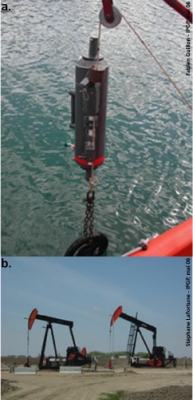
Thèses soutenues en 2007
Noble gas, N2 and O2 isotopes for surveying injected CO2 migrations inside geological storage reservoirs, and for predicting leakage
sous la co-direction de Pierre AGRINIER et de Manuel MOREIRA (Laboratoire de Géochimie et Cosmochimie) : soutenue le 30 novembre 2007 (http://www.ipgp.jussieu.fr/~lafortun/these/)
To attenuate the impact of anthropogenic carbon dioxide emissions, CO2 can be stored in natural reservoirs (aquifers, oil- and gasfields).

The total amount of stored CO2 and its mean residence time in reservoirs depend on the result of the competition between the three major phenomena governing the storage: (1) migrations of CO2 in the storage reservoirs (controlled by hydrodynamic fluxes); (2) kinetics of mineralogical reactions which can durably fix CO2 in a stable (solid) form; (3) leakage of CO2 out of the reservoirs through the top, bottom or lateral barriers.
The study of the trapping efficiency of geological formations is fundamental in order to evaluate the pertinence and safety (in terms of human and environmental risks) of a reservoir. The reservoirs must have a good trapping structure with reduced leakage rates. Assessment of these leakage rates (thanks to predictive modelling or a set of adapted observation wells) will make it possible to determine any likely impact on the environment (fig.1).

On present storage sites, CO2 is injected in a no-pure phase and the injected gas contains air elements. N2 and Ar (or other noble gases contained in the injected gas) would be used as tracers or precursors, the monitoring and concentration evolution of which would warn of possible future CO2 leakage in reservoir surrounding formations. This stems from the possibility that these gases migrate faster than CO2 because they are smaller, lighter and relatively inert. O2 which is a highly reactive compound in reducing environments could be a useful tool for marking leaks associated with the set of injection wells (upstream leaks).
We will try to validate our monitoring method on natural (like volcanic lakes - fig.2a) or anthropogenic CO2 storage sites. A scientific collaboration with the "IEA GHG Weyburn CO2 Monitoring & Storage Project" (a CO2 injection project in an EnCana oilfield realized to enhance the oil recovery - website) will permit to access to the Weyburn oilfield (fig.2b) and to sample firstly the injected gas and the storage formation (fluids and rocks), and in the future the aquifers just above and below the storage.
Our theoretical and analytical results will try to highlight the relevance of using the compounds as warning signals for CO2 leakage and as tools for studying the trapping efficiency of a reservoir before massive injection of CO2.

Institut de Physique du Globe de Paris - Mise à jour 11/2024
Site publié avec e-Lectron - Contact : Webmaster IPGP